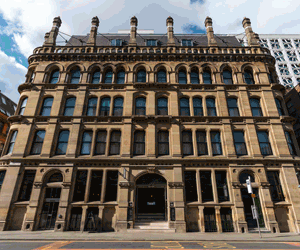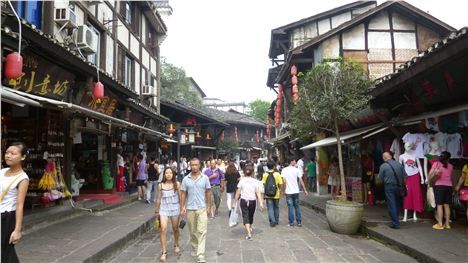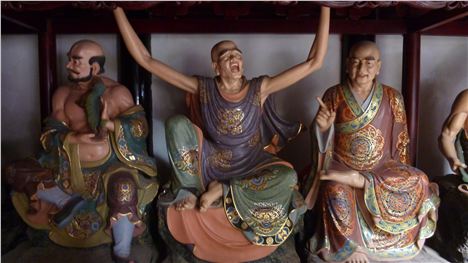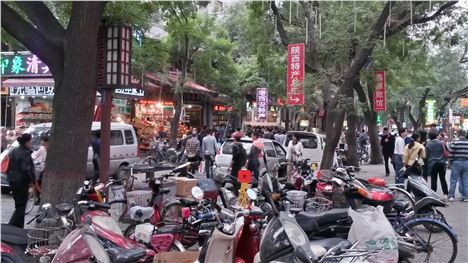THOUGH located around a comma-shaped peninsula at the confluence of the Jailing and Yangtze Rivers, the sprawling megalopolis of Chongqing—translated as ‘Double Celebration’ - offers little pause in China’s relentless pursuit of growth.
Perhaps the most resplendent of all China’s touristic jewels, maybe in the entire world, had to be its entrant on the list of the world’s great ancient capitals – Xi’an.
The grinding march of industrialisation has driven the populace (33 million and counting) and architecture skywards. Babelesque in its concrete climb from the ochre-hued rivers, streets rise and fall as they follow the undulating topography (think a miniature Hong Kong meets a foggy San Francisco).
The nearby ancient town of Ciqikou (Porcelain Village) offers a bite-sized glimmer of Chongqing during Ming and Qing times, but due to saturation bombing inflicted by the Japanese during the war little else remains to illustrate Chongqing’s former glory, particularly its role as capital of the ancient Ba Kingdom.
Today Chongqing - from a tourist’s perspective - serves largely as a port of destination or departure for Yangtze River cruises. With a rapidly expanding airport it’s also well connected to Lhasa, Kunming, and Xi’an.
Watching the city’s fluorescent skyline pierce the fading light from on board my ship, the Victoria Jenna, before departing for a three-night cruise along the Yangtze, was a much treasured travel moment. A symphony of neon, darkness clearly favours this city and it’s hard not to be bewitched by its night-time charm. The top deck of our boat was a crescendo of camera flashes as almost every passenger on board gathered on the top deck as we sailed out of the city, leaving behind its karaoke-thrummed soundtrack for the silent, eerie darkness of the Yangtze and its ghosts of submerged cities past.
A notable highlight, on our river cruise, was Fengdu Ghost City. A collection of Buddhist and Taoist temples set atop Ming Mountain, Fengdu’s images, landmarks, and statues depict the bureaucracy each soul must undergo in the netherworld (reminiscent of Hades, the Greek underworld) on their way to receiving their final judgement. These included ‘The Bridge of Helplessness’; ‘Ghost Torturing Pass’ where one reports to Yama, the King of Hell, for judgement; ‘Nothing-To-Be-Done Bridge’ and ‘Last-Glance at Home Tower’.
I also enjoyed seeing the hanging cliff coffins along the banks of the Shennong Stream of which a Tang poet, so obviously inspired by them, wrote:
Roots lock the dead bodies,
Solitary bones suspended like an owl nest.
Branches cry towards clouds,
sad rhythm echo now and then.
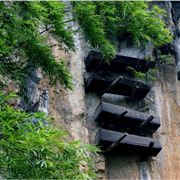 Hanging CoffinsThese caskets, precariously wedged in the limestone bluffs of the precipice, hang anywhere between 33 and several hundred feet above the ground. Despite it being a case of blink and you’ll miss them, everyone marvelled at just how they must have got them up there some 2,000 years ago.
Hanging CoffinsThese caskets, precariously wedged in the limestone bluffs of the precipice, hang anywhere between 33 and several hundred feet above the ground. Despite it being a case of blink and you’ll miss them, everyone marvelled at just how they must have got them up there some 2,000 years ago.
But perhaps the most resplendent of all China’s touristic jewels, maybe in the entire world, had to be its entrant on the list of the world’s great ancient capitals – Xi’an.
Damn, I loved this place.
Though not as immediately commanding as Rome or as bewitching as Marrakech, the fact it marked the beginning of the ancient Silk Road which, commencing in the Han dynasty, would eventually wend its way through the Indian subcontinent, Persia, Europe, and Arabia, has armed Xi’an with enough magisterial splendour and archaeological artefacts to impress even the most demanding of tourists (yes, I’m looking at you, you jaw-dropping, stadium-sized pits of Terracotta Warriors and Horses).
God bless the first Emperor of China, Qin Shi Huang, is all I can say. Whereas most modern-day teenagers may hanker after an iPad on which to launch an assault on the latest video games, the adolescent Emperor Qin was stretching his imagination to accommodate such paltry designs as the Great Wall of China and the aforesaid Terracotta Army which, he hoped, would protect him against any would-be assaults in the afterlife.
But what most lit me up like a sky full of firecrackers had to be Xi’an’s Muslim Quarter with its Great Mosque which was founded in 742 CE. On arriving in Xi’an I was struck down with a fever which threatened to place me under hotel arrest. So it was in the spirit of Lazarus that I summoned my strength and headed across the city, on foot, to check out this neighbourhood which lies just behind (north) the Drum Tower. I’m so glad I did. Intoxicating is just one of many scant adjectives I could use to describe this district.
When I turned the corner onto the main street, my senses were assailed by a cacophony of smells and contented slurping sounds (the street snacks here attract swarms of hungry visitors) set against a backdrop of motorcycle horns and vendors’ cries. When I disappeared into the ever narrowing bowels of the labyrinthine market, I feared I may never be seen again. Fortunately, a market trader spat me out after I haggled her down to a brazen price (in her opinion at least) on a pair of porcelain tea light holders.
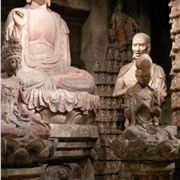 Shaanxi Provincial History MuseumAnd have I mentioned Xi’an’s magnificent ancient city wall built in the Ming Dynasty which continues to hold the entire old city in place? Or the Giant Wild Goose Pagoda which leans in a similar spirit to Italy’s Tower of Pisa? Then there’s the day-long absorbing Shaanxi Provincial History Museum, and the Bell and Drum Towers which are a spectacle to behold especially when illuminated at night - the list is endless.
Shaanxi Provincial History MuseumAnd have I mentioned Xi’an’s magnificent ancient city wall built in the Ming Dynasty which continues to hold the entire old city in place? Or the Giant Wild Goose Pagoda which leans in a similar spirit to Italy’s Tower of Pisa? Then there’s the day-long absorbing Shaanxi Provincial History Museum, and the Bell and Drum Towers which are a spectacle to behold especially when illuminated at night - the list is endless.
‘The greatness of this country lies in the inexorable journey it has taken through time’, wrote the author, Yo Yo. As China’s cradle of civilisation, the eternal city of Xi’an proves a definitive living history book for those who wish to learn more of this country’s sweeping several-thousand-year-old story.
Follow Thea on Twitter @TheaEuryphaessa
Getting there
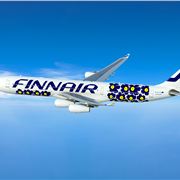 Thea flew from Manchester to Chongqing and Xi´an with Finnair. Finnair flies to Chongqing four times per week from Manchester and London Heathrow via its hub in Helsinki and three times a week to Xi’an from March to October. Finnair is the only European airline to offer a direct connection from Europe to Chongqing and Xi´an.
Thea flew from Manchester to Chongqing and Xi´an with Finnair. Finnair flies to Chongqing four times per week from Manchester and London Heathrow via its hub in Helsinki and three times a week to Xi’an from March to October. Finnair is the only European airline to offer a direct connection from Europe to Chongqing and Xi´an.
The below return fares include taxes, service and booking fees starting from:
Manchester—Chongqing:
Business class: £1,827
Economy class: £493
London—Chongqing:
Business class: £1,506
Economy class: £523
Business class: £2,069
Economy class: £493
London—Xi´an:
Business class: £2,098
Economy class: £523
Tickets can be booked at www.finnair.co.uk or 0870 2414411.
For up-to-date offers and news follow Finnair on Twitter @finnairuk. Also visit Finnair on Facebook at facebook.com/finnair
Helsinki—Chongqing—Helsinki timetable
Helsinki—Chongqing:
AY055 17:45—08:15+1 (flight time 8h 30mins)
Chongqing—Helsinki:
AY056 10:25—14:05 (flight time 9h 40mins)
Helsinki—Xi´an—Helsinki timetable
Helsinki—Xi´an:
AY059 17:40—06:30 +1 (flight time 7h 50mins)
Xi´an—Helsinki:
AY060 10:35—14:15 (flight time 8h 40mins)
Manchester—Helsinki—Manchester timetable (two flights daily)
Manchester—Helsinki:
AY2934 10:25am—3:10pm
AY2938 5:50pm –10:30pm
Helsinki—Manchester:
AY2933 8:25am—9:25am
AY2937 4:05pm—5pm
Finnair has also five daily return flights from London Heathrow to Helsinki.
Finnair also flies to eleven other Asian cities: Singapore, Tokyo, Nagoya, and Osaka in Japan; Seoul in Korea; Delhi in India; Bangkok in Thailand; Hanoi in Vietnam; Hong Kong, Shanghai, and Beijing in China.
Staying there:
Thea stayed at Hotel InterContinental in Chongqing; sailed with Victoria Cruises upon the Victoria Jenna down the Yangtze River; stayed at theCrowne Plaza in Yichang; and the Hilton in Xi’an.







